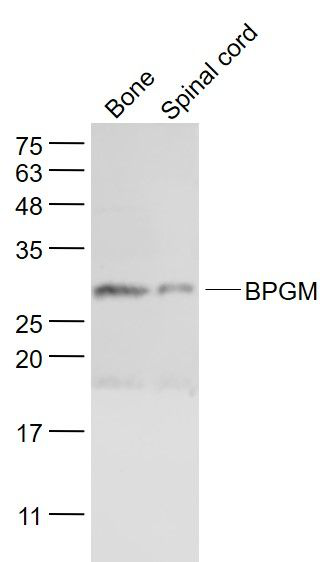产品货号 : mlR9519
英文名称 : BPGM
中文名称 : 红细胞2,3 - 二磷酸甘油酸合成酶抗体
别 名 : 2,3-bisphosphoglycerate mutase; 2,3-bisphosphoglycerate synthase; 3-bisphosphoglycerate mutase; 3-bisphosphoglycerate synthase; 3-diphosphoglycerate mutase; Ab2 098; AI323730; AL022789; Bisphosphoglycerate mutase; BPG dependent PGAM; BPG-dependent PGAM ; Bpgm; BPGM; C86192; DPGM; Erythrocyte 2,3 bisphosphoglycerate mutase; PMGE_HUMAN; 2,3-bisphosphoglycerate mutase, erythrocyte; erythrocyte; 2 antibody.
研究领域 : 肿瘤 心血管 细胞生物 信号转导
抗体来源 : Rabbit
克隆类型 : Polyclonal
交叉反应 : Human, Mouse, Rat, Cow, Rabbit, Sheep,
产品应用 : WB=1:500-2000 ELISA=1:500-1000 IHC-P=1:400-800 IHC-F=1:400-800 IF=1:50-200 (石蜡切片需做抗原修复)
not yet tested in other applications.
optimal dilutions/concentrations should be determined by the end user.
分 子 量 : 30kDa
细胞定位 : 细胞浆 细胞外基质 分泌型蛋白
性 状 : Lyophilized or Liquid
浓 度 : 1mg/ml
免 疫 原 : KLH conjugated synthetic peptide derived from human BPGM:101-200/259
亚 型 : IgG
纯化方法 : affinity purified by Protein A
储 存 液 : 0.01M TBS(pH7.4) with 1% BSA, 0.03% Proclin300 and 50% Glycerol.
保存条件 : Store at -20 °C for one year. Avoid repeated freeze/thaw cycles. The lyophilized antibody is stable at room temperature for at least one month and for greater than a year when kept at -20°C. When reconstituted in sterile pH 7.4 0.01M PBS or diluent of antibody the antibody is stable for at least two weeks at 2-4 °C.
PubMed : PubMed
产品介绍 : BPGM (2,3-bisphosphoglycerate mutase) is a 259 amino acid protein that belongs to the phosphoglycerate mutase family and exists as a homodimer that plays a crucial role in the regulation of hemoglobin oxygen. Specifically, BPGM catalyzes the conversion of 3-phospho-D-glyceroyl phosphate to 2,3-bisphospho-D-glycerate (2,3-BPG), a reaction that is essential for controlling the concentration of 2,3-BPG within the cell. The gene encoding BPGM maps to human chromosome 7, which houses over 1,000 genes and comprises nearly 5% of the human genome. Defects in some of the genes localized to chromosome 7 have been linked to Osteogenesis imperfecta, Williams-Beuren syndrome, Pendred syndrome, Lissencephaly, Citrullinemia and Shwachman-Diamond syndrome.
Involvement in disease:
Defects in BPGM are the cause of bisphosphoglycerate mutase deficiency (BPGMD) . A disease characterized by hemolytic anemia, splenomegaly, cholelithiasis and cholecystitis.
Function:
Plays a major role in regulating hemoglobin oxygen affinity by controlling the levels of its allosteric effector 2,3-bisphosphoglycerate (2,3-BPG). Also exhibits mutase (EC 5.4.2.1) and phosphatase (EC 3.1.3.13) activities.
Subunit:
Homodimer.
Tissue Specificity:
Expressed in red blood cells. Expressed in non-erythroid cells of the placenta; present in the syncytiotrophoblast layer of the placental villi at the feto-maternal interface (at protein level).
Post-translational modifications:
Glycation of Lys-159 in diabetic patients inactivates the enzyme.
DISEASE:
Defects in BPGM are the cause of bisphosphoglycerate mutase deficiency (BPGMD) [MIM:222800]. A disease characterized by hemolytic anemia, splenomegaly, cholelithiasis and cholecystitis.
Similarity:
Belongs to the phosphoglycerate mutase family. BPG-dependent PGAM subfamily.
SWISS:
P07738
Gene ID:
669
Important Note:
This product as supplied is intended for research use only, not for use in human, therapeutic or diagnostic applications.
产品图片












